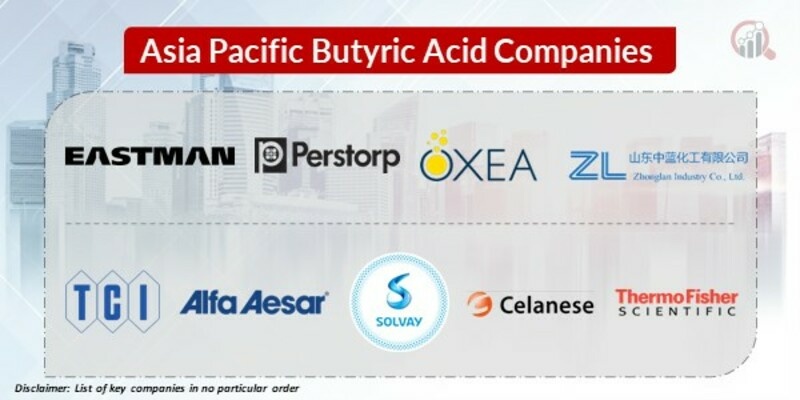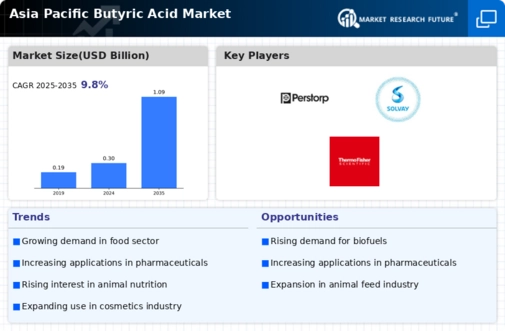Top Industry Leaders in the Asia Pacific Butyric Acid Market

The Asia Pacific butyric acid market is witnessing a surge in demand driven by its diverse applications across industries. From food and beverage to pharmaceuticals and renewable energy, this versatile four-carbon fatty acid plays a crucial role in the region's commitment to sustainability. Navigating this competitive landscape requires understanding the key players, their strategies, and the factors driving market share.
Strategies Fuelling Growth:
- Innovation and Diversification: Players are actively investing in R&D to develop new butyric acid derivatives and cater to specific industry needs. Examples include BASF's focus on renewable, bio-based butyric acid for the pharmaceutical industry and Eastman's development of advanced feed additives to boost animal health.
- M&A and Strategic Partnerships: Consolidation is a key trend, with companies like Wilmar acquiring smaller players to expand their product offerings and geographical reach. Partnerships are also flourishing, like Wilmar's collaboration with Jubilant Life Sciences to establish a butyric acid production facility in India.
- Sustainability Focus: The growing demand for eco-friendly solutions is driving the development of bio-based butyric acid. Companies like LG Chem are utilizing corn and other renewable feedstocks to cater to this sustainable niche market.
Factors Dictating Market Share:
- Regional Economic Growth: Booming economies like China and India are witnessing a rise in disposable incomes, fueling demand for meat, dairy, and processed foods, which in turn boost the animal feed and food additive segments.
- Regulatory Landscape: Stringent regulations on animal feed additives and pharmaceutical ingredients are influencing product formulations and creating opportunities for manufacturers who comply with evolving standards.
- Technological Advancements: Advances in fermentation and bio-production technologies are reducing production costs and enabling the development of cleaner, more sustainable butyric acid, increasing its appeal across industries.
List of Key Players in the Asia Pacific Butyric Acid Market
- Eastman Chemical Company (U.S.)
- Perstorp (Sweden)
- Oxea GmbH (Germany)
- Zhonglan Industry Co., Ltd. (China)
- Tokyo Chemical Industry Co., Ltd. (Japan)
- Alfa Aesar (U.S.)
- Jinan Haohua Industry Co., Ltd.(China)
- Solvay (Belgium)
- Celanese Corporation (U.S.)
- Thermo Fisher Scientific Inc. (U.S.)
- Aldon Corporation (U.S.)
Recent Developments:
July 2023: Wilmar and Jubilant Life Sciences commence initial operations at their newly established butyric acid production facility in India, aiming to capture a significant share of the regional market.
September 2023: Sinopec unveils plans to expand its butyric acid production capacity by 20%, responding to the burgeoning demand from the pharmaceutical and animal feed industries.
November 2023: LG Chem successfully develops a novel fermentation process for bio-based butyric acid production, potentially disrupting the traditional production methods and lowering costs.
January 2024: Regulatory authorities in Japan approve the use of butyric acid as a food additive, opening up a new market segment for manufacturers in the region.









